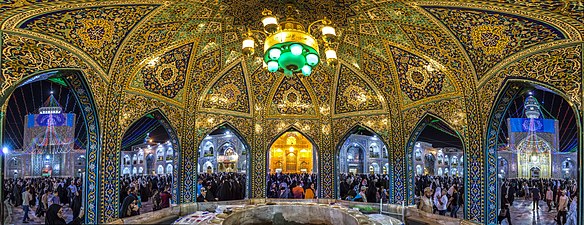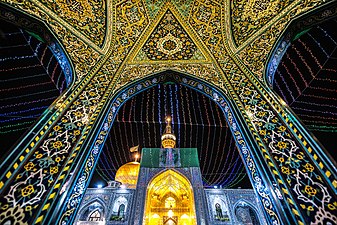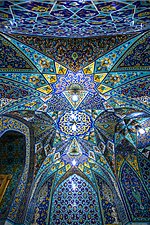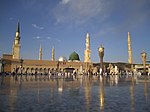Imam Reza shrine
| Imam Reza shrine | |
|---|---|
حرم امام رضا | |
 | |
| Religion | |
| Affiliation | Shia Islam |
| Leadership | Imam(s): Ahmad Marvi |
| Location | |
| Location | Mashhad, Iran |
| Administration | Astan Quds Razavi |
| Geographic coordinates | 36°17′17″N 59°36′57″E / 36.2880°N 59.6157°E |
| Architecture | |
| Type | Mosque |
| Style | Abbasid Islamic |
| Date established | 818 |
| Specifications | |
| Capacity | 700,000 |
| Minaret(s) | 12 |
| Minaret height | 70 m (230 ft) |
| Site area | 1,000,000 square metres (250 acres) |
| Website | |
| www | |
The Imam Reza shrine (
The complex is a tourism center in Iran[2][3] and has been described as "the heart of the Shia Iran"[4] with 25 million Iranian and non-Iranian Shias visiting the shrine each year, according to a 2007 estimate.[5]
The shrine itself covers an area of 267,079 square metres (2,874,810 sq ft) while the seven courtyards which surround it cover an area of 331,578 square metres (3,569,080 sq ft), totaling 598,657 m2 (6,443,890 sq ft).[6]
Religious significance
Shia sources quote several hadiths from the Shia Imams and Muhammad that highlight the importance of pilgrimage to the shrine. A hadith from Muhammad says:
One of my own flesh and blood will be buried in the land of Khorasan. God the Highest will surely remove the sorrows of any sorrowful person who goes on pilgrimage to his shrine. God will surely forgive the sins of any sinful person who goes on pilgrimage to his shrine.[7]
History
Early years
Dar-ul-Imarah (Royal Residence) or the garden of
Martyrdom of Ali al-Ridha

In 818,
The celebrated Muslim traveler Ibn Battuta visited Mashhad in 1333 and reported that it was a large town with abundant fruit trees, streams and mills. A great dome of elegant construction surmounts the noble mausoleum, the walls being decorated with colored tiles. Opposite the tomb of the Imam is the tomb of Caliph Harun al-Rashid, which is surmounted by a platform bearing chandeliers.[2]
By the end of the third
Saljug era

Mongol invasion
During the
Timurid era
The glorious phase of Mashhad started during the reign of
Safavid era

With the emergence of the Safavid dynasty in 1501 A.D. and their declaration of the Twelver Shi'ite sect as the state religion, Mashhad reached the peak of its development. However, since Khorasan was a border province of the Safavid Empire, Mashhad suffered repeated invasions and periods of occupation by the Uzbek Khans – Muhammad Khan, Abdullah Khan Shaibani, Muhammad Sultan and especially Abdul-Momen Khan. These invasions continued up to 996 A.H./ 1586 A.D., the reign of
During the Safavid era, the shrine also received patronage from rulers of the Indian subcontinent, namely
Afsharid and Qajar era


Following the coup in December 1911, Russian artillery shelled revolutionaries who had taken refuge in the shrine.[16] The whole complex was greatly damaged in 1911, but it was repaired after a while.
Modern era

There happened some essential changes round the complex in 1347/1928. Old Falakah was extended up to a radius of 620 meters before the victory of the
On 11th Rabi al-Thani 1354 A.H. /13 July 1935, during the
The shrine is depicted on the reverse of the Iranian 100 rials coin, issued since 2004.[17]
Incidents
Commune kitchen
The harem kitchen dines 10 to 40 thousand visitors/tourists a day and sometimes on occasional events cook as many as 250,000. It has an Astan quds website page and there is an ID register and ticket lottery for a meal one course per person every three year.[18][19] During Ramadan Commune kitchen feed one million pilgrim and citizens.[20]
Specifications
Courtyards (Sahn)

The complex contains a total of seven courtyards, which cover an area of over 331,578 m2 (3,569,080 sq ft):[21] The courtyards also contain a total of 14 minarets,[22] and three fountains.[23]
| Name | Images | Area (m2) | appurtenant | Year of first building |
|---|---|---|---|---|
| Revolution Courtyard | four balconies, steel window | [[{{{1}}}]] | ||
| Freedom Courtyard | 4,600 | golden Veranda | [[{{{1}}}]] | |
| Courtyard of Goharshad Mosque | [[{{{1}}}]] | |||
| Quds Courtyard | 2,500 | [[{{{1}}}]] | ||
| Islamic Republic Courtyard | 10,000 | two minarets | [[{{{1}}}]] | |
| The Razavi Grand Courtyard | [[{{{1}}}]] | |||
| Gadeer Courtyard | [[{{{1}}}]] |
Halls
From the courtyards, external hallways named after scholars lead to the inner areas of the mosque. They are referred to as
- Bast Shaykh Toosi – leads to the Central Library
- Bast Shaykh Tabarsi
- Bast Shaykh Hur Ameli
- Bast Shaykh Baha'i
The Bast hallways lead towards a total of 21 internal halls (
Goharshad Mosque

This mosque is situated adjacent to the shrine of Imam Ridha.
Ali al-Ridha's Tomb

It is located beneath the Golden Dome and surrounded by different porches each bearing a separate name.
Museums and other historical appurtenants
There are two museums within the shrine limits. Astan Quds Museum and Quran Museum.
Notable burials
| Name | Lifespan | Notes | |
|---|---|---|---|
| Birth | Died | ||
| Harun al-Rashid | 763 | 809 | caliph (786–809)
|
Imam Ali Reza
|
765 | 818 | 8th Imam (798–818)
|
| Shaykh Ahmad Tabarsi | 1073 | 1153 | Scholar |
| Sevin Beg Khanzada | 1360 | 1412 | Timurid dynasty Princess |
| Abul-Qasim Babur Mirza | 1422 | 1457 | Timurid dynasty Prince |
| Sultanum Begum | 1516 | 1593 | Queen consort of Shah Tahmasp I |
| Allahverdi Khan | 1560 | 1613 | Iranian General of Georgian origin |
Shaykh Baha'i
|
1547 | 1621 | Islamic Scholar |
| Dilaram Khanum | ? | 1647 | Consort of Safavid Prince and mother of Shah Safi |
Muhammad al-Ḥurr al-ʿĀmilī
|
1624 | 1693 | Shia cleric |
| Abbas Mirza | 1789 | 1833 | Qajar Crown Prince |
| Mohammad-Taqi Mirza | 1791 | 1853 | Qajar Prince |
| Mohammad Baqer Sharif Tabatabai | 1823 | 1901 | Scholar |
| Abu Talib Zanjani | 1843 | 1911 | Scholar |
| Princess Ashraf os-Saltaneh | 1863 | 1914 | Qajar Princess |
| Mass'oud Mirza Zell-e Soltan | 1850 | 1918 | Qajar prince |
| Hassan Ali Nokhodaki Isfahani | 1862 | 1942 | cleric |
| Ahmed Aref El-Zein | 1884 | 1960 | Scholar |
| Forough Azarakhshi | 1904 | 1963 | scholar |
| Ali-Akbar Fayyaz | 1898 | 1971 | Scholar |
| Muhammad Taqi Amoli | 1887 | 1971 | cleric |
| Mohammad Hadi al-Milani | 1895 | 1975 | Scholar |
| Manouchehr Eghbal | 1909 | 1977 | Prime Minister (1957–60) and CEO of NIOC
|
| Asadollah Alam | 1919 | 1978 | Prime minister (1962–64) and minister of the Imperial Court (1967–77) |
| Gholam Husayn Tabrizi | 1881 | 1980 | Scholar |
| Ali Motamedi (fa) | 1896 | 1980 | diplomat and politician |
| Mahmoud Farrokh Khorasani (fa) | 1895 | 1981 | politician |
| Abdol Karim Hasheminejad | 1932 | 1981 | cleric |
| Abdullah Musawi Shirazi | 1892 | 1984 | cleric |
| Gholamreza Ghodsi | 1925 | 1989 | poet |
| Badri Teymourtash | 1908 | 1995 | scholar |
| Mohammad Taqi Jafari | 1925 | 1998 | cleric |
| Ali Akbar Aboutorabi Fard | 1939 | 2000 | cleric |
| Hasan Ali Morvarid | 1911 | 2004 | cleric |
| Syed Jalaleddin Ashtiani | 1925 | 2005 | cleric |
| Hassan Tabatabaei Qomi | 1912 | 2007 | cleric |
| Mohammad-Sadegh Farman (fa) | 1921 | 2012 | politician |
| Mohammad Ezodin Hosseini Zanjani | 1921 | 2013 | cleric |
| Mohammad Baqer Shirazi | 1931 | 2014 | cleric |
| Abbas Vaez-Tabasi | 1935 | 2016 | cleric and chairman of the supervisory board of Astan Quds Razavi (1979–2016) |
| Hassan Firouzabadi | 1951 | 2021 | Military commander and Chief of Staff of the Iranian Armed Forces (1989–2016) |
- caliph(786–809)
- Imam(798–818)
- Shaykh Tabarsi (1073–1153) – Scholar
- Sevin Beg Khanzada (c. 1360 – 1411) – Timurid princess
- Abul-Qasim Babur Mirza (1422–1457) – Timurid prince
- Sultanum Begum (1516–1593) – Queen consort
- Allahverdi Khan (ალავერდი ხანი უნდილაძე) (c. 1560–1613) – Iranian general of Georgian origin
- Sheikh-e Baha'i(1547–1621) – Scholar
- Dilaram Khanum (d. 1647) – Queen consort
- Horr-e Ameli(1624–1693) – cleric
- Crown Prince Abbas Mirza (1789–1833) – Qajar Crown Prince
- Prince Mohammad-Taqi Mirza (1791–1853) – Qajar prince
- Mohammad-Baqer Sharif Tabatabai (1823–1901) – Scholar
- Abutaleb Zanjani (1843–1911) – Scholar
- Prince Mass'oud Mirza Zell-e Soltan (1850–1918) – Qajar prince
- Hassan Ali Nokhodaki Isfahani (1862–1942) – cleric
- Ahmed Aref El-Zein (1884–1960) – Scholar
- Forough Azarakhshi (1904–1963) – scholar
- Mohammad-Taqi Amoli (1887–1971) – cleric
- Ali-Akbar Fayyaz (1898–1971) – scholar
- Mohammad-Hadi Milani (1895–1975) – Scholar
- NIOC
- Asadollah Alam (1919–1978) – prime minister (1962–64) and minister of the Imperial Court (1967–77)
- Gholam-Hossein Tabrizi (1881–1980) – Scholar
- َAli Motamedi (fa) (1896–1980) – diplomat and politician
- Mahmoud Farrokh Khorasani (fa) (1895–1981) – politician
- Abdolkarim Hasheminejad (1932–1981) – cleric
- Abdollah Musavi Shirazi (1892–1984) – cleric
- Gholamreza Ghodsi (1925–1989) – poet
- Badri Teymourtash (1908–1995) – scholar
- Mohammad-Taqi Jafari (1925–1998) – cleric
- Ali-Akbar Aboutorabi Fard (1939–2000) – cleric
- Hassan-Ali Morvarid (1911–2004) – cleric
- Jalaleddin Ashtiani (1925–2005) – cleric
- Hassan Tabatabaei Qomi (1912–2007) – cleric
- Mohammad-Sadegh Farman (fa) (1921–2012) – politician
- Mohammad Ezodin Hosseini Zanjani (1921–2013) – cleric
- Mohammad Baqer Shirazi (1931–2014) – cleric
- Abbas Vaez-Tabasi (1935–2016) – cleric and chairman of the supervisory board of Astan Quds Razavi (1979–2016)
- Hassan Firouzabadi (1951–2021) – military commander and Chief of Staff of the Iranian Armed Forces (1989–2016)
Gallery
See also
- Holiest sites in Shia Islam
- Astan Quds Razavi
- Fatima Masumeh Shrine
- Shah Abdol-Azim Shrine
- Goharshad Mosque
- Howz-e Ma'jardar Mosque
References
- ^ "The Islamic Seminaries At The Holy Shrine". Imam Reza (A.S.) Network. Archived from the original on 2008-05-30. Retrieved 2009-05-26.
- ^ a b "Sacred Sites: Mashhad, Iran". sacredsites.com. Archived from the original on 2010-11-27. Retrieved 2006-03-13.
- ^ "Religious Tourism Potentials Rich". Iran Daily. Archived from the original on June 12, 2008. Retrieved 2009-05-25.
- ^ Hafiz, Yasmine (2014-04-24). "Imam Reza Shrine Is The Heart Of Shi'ite Iran And The World's Largest Mosque-- See It Through A Pilgrim's Eyes (PHOTOS)". Huffington Post. Archived from the original on 2017-05-08. Retrieved 2017-10-24.
- from the original on 2016-04-24. Retrieved 2017-10-24.
- ^ "The Glory of the Islamic World". Imam Reza (A.S.) Network. Archived from the original on 2010-06-12. Retrieved 2009-05-25.
- ^ Uyun Akhbar al-Ridha. Vol. 2. 23 July 2015. Archived from the original on 24 October 2017. Retrieved 24 October 2017.
- ^ Staff Writer (24 January 2012). "Look at the history of Imam Reza's burial ground (Persian)". mashreghnews. Archived from the original on 11 November 2017. Retrieved 11 November 2017.
- ISBN 978-1502834249. Archivedfrom the original on 2023-08-07. Retrieved 2020-10-18.
- ^ Zabeth (1999) pp. 12-16
- ^ ISBN 9781595844613. Archivedfrom the original on 2023-08-07. Retrieved 2020-10-18.
- ^ a b c Staff Writer. "How the shrine of Imam Reza was built?". Iranian student's news agency. Archived from the original on 15 October 2016. Retrieved 4 January 2014.
- ISBN 9781461731917. Archivedfrom the original on 2023-08-07. Retrieved 2020-10-18.
- ISBN 9789644442216. Archivedfrom the original on 2023-08-07. Retrieved 2020-10-18.
- )
- ^ Michael Axworthy, A History of Iran: Empire of the Mind, (Basic Books, 2010), 212.
- ^ Central Bank of Iran Archived 2021-02-03 at the Wayback Machine. Banknotes & Coins: 100 Rials Archived 2018-07-28 at the Wayback Machine. – Retrieved on 24 March 2009.
- ^ "نحوه ثبت نام در مهمانسرای حرم امام رضا (ع)". 20 February 2020. Archived from the original on 2022-04-06. Retrieved 2023-08-07.
- ^ "Archived copy". Archived from the original on 2023-08-07. Retrieved 2023-08-07.
{{cite web}}: CS1 maint: archived copy as title (link) - ^ "توزیع بیش از یک میلیون بسته افطاری در حرم رضوی - ایسنا".
- ^ "Sahn (Courtyards) Around the Holy Shrine". Imam Reza (A.S.) Network. Archived from the original on 2008-05-29. Retrieved 2009-05-26.
- ^ "Minarets". Imam Reza (A.S.) Network. Archived from the original on 2008-05-30. Retrieved 2009-05-26.
- ^ "Saqqah Khaneh". Imam Reza (A.S.) Network. Archived from the original on 2010-06-12. Retrieved 2009-05-26.
- ^ "The Bast (Sanctuaries) Around the Holy Shrine". Imam Reza (A.S.) Network. Archived from the original on 2010-06-12. Retrieved 2009-05-26.
- ^ "Riwaq (Porch)". Imam Reza (A.S.) Network. Archived from the original on 2010-06-12. Retrieved 2009-05-26.
- ^ "The Bala-Sar Mosque of the Holy Shrine". Imam Reza (A.S.) Network. Archived from the original on 2010-06-12. Retrieved 2009-05-26.
- Zabeth, Hyder Reza (1999). Landmarks of Mashhad. Alhoda UK. ISBN 9644442210.
Bibliography
- D. M. Donaldson: 'Significant Miḥrābs in the Ḥaram at Mas̱ẖhad', A. Islam., ii (1935), pp. 118–27
- A. U. Pope and P. Ackerman, eds: Survey of Persian Art (2/1964–7), pp. 1201–11
- B. Saadat: The Holy Shrine of Imam Reza, Mashhad, 4 vols (Shiraz, 1976)
- Nasrine Hakami, Pèlerinage de l'Emâm Rezâ: Étude Socio-économique (Tokyo: Institute for the Study of Languages and Cultures of Asia and Africa, 1989)
- C. P. Melville: 'Shah ‛Abbas and the Pilgrimage to Mashhad', Safavid Persia: The History and Politics of an Islamic Society, ed. C. P. Melville (London, 1996), pp. 191–229
- ʿA.-Ḥ. Mawlawī, M. T.Moṣṭafawī, and E. Šakūrzāda (2011). "Āstān-e Qods-e Rażawī". Encyclopædia Iranica.
{{cite encyclopedia}}: CS1 maint: multiple names: authors list (link)
External links
![]() Media related to Imam Reza Shrine at Wikimedia Commons
Media related to Imam Reza Shrine at Wikimedia Commons
- Astan Quds Razavi Archived 2016-01-09 at the Wayback Machine
- Non-Iranian Pilgrims Website Archived 2016-02-26 at the Wayback Machine
- Razavi Pharmaceutical Service Institute






















